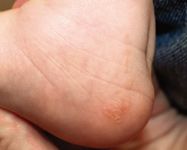"Chicken skin" in a newborn
During a newborn examination, you note a yellow streak on the foot of a healthy newborn.
THE CASE
During a newborn examination, you note a yellow streak on the foot of a healthy newborn (Figure).
Diagnosis: Nevus sebaceous

Under the influence of maternal and/or neonatal hormones, these lesions tend to be thickened and pebbly in the newborn and flatten over 4 to 6 months. At puberty, they often become elevated, with a bumpy, verrucous, or scaly appearance. Lesions are often linear or crescent shaped.2
Lesions may be associated with benign or malignant tumors. Common benign neoplasms are warts, syringocystadenoma papilliferum, and trichoblastoma. The most common malignancy is basal cell carcinoma. Malignancy usually arises after puberty and can present as ulceration, rapid growth, or nodules.3 However, the risk of malignant transformation in nevus sebaceous is less than 1%.4
In children with particularly large sebaceous nevi, the lesions may be associated with an epidermal nevus syndromes (ie, Schimmelpenning syndrome or phacomatosis pigmentokeratotica). In the former, extracutaneous findings include anomalies of the central nervous system, bone, and eye. In children with phacomatosis pigmentokeratotica, an extensive nevus sebaceous is associated with a papular speckled lentiginous nevus. In addition to the symptoms described with Schimmelpenning, phacomatosis pigmentokeratotica also presents with hyperhidrosis, cutaneous dysesthesia, muscular weakness, and sensorimotor neuropathy in the area of the lentiginous nevus.5
DIFFERENTIAL DIAGNOSIS
The differential diagnoses for yellow lesions on the foot include xanthomas and xanthogranulomas. Linear foot lesions include warts, lichen striatus, linear epidermal nevus, and linear nevus lipomatosus superficialis.
Xanthomas are characterized by accumulations of lipid-laden macrophages. They tend to be nodular and appear in multiples bilaterally. Juvenile xanthogranulomas are a type of non-Langerhan's cell histiocytosis. They usually appear dome-shaped, papular, or nodular.
Warts are usually skin colored or slightly hyperpigmented and rough in texture. Lichen striatus is a self-limited linear eruption that usually develops between the ages of 5 and 15 years. They appear as pink, flat-topped, minimally scaly papules, which over time may coalesce to form a linear band. Linear epidermal nevi may be mistaken for warts. They are often congenital, presenting as flat tan or brown macules or minimally scaly papules that become thickened and warty with age. Finally, nevus lipomatosus superficialis is a benign skin malformation characterized by ectopic adipocytes in the upper dermis. They present as skin-colored or yellow, pedunculated, soft, cerebriform papules and nodules.
Sebaceous nevi on the scalp may resemble cutis aplasia, which has a smooth, shiny, scarred surface; early juvenile xanthogranulomas; solitary mastocytoma, which becomes urticarial when scratched; or nevus syringocystadenomatous papilliferous, which is usually pink and nodular rather than yellow and velvety.
PATHOLOGY
Histopathologic findings include hyperplasia of sebaceous glands with abortive hair follicles, papillomatosis, and hyperkeratosis. Sebaceous glands are most prominent in lesions on newborns or adolescents.
TREATMENT
Prophylactic excision of the sebaceous nevus is usually not required. Instead, the lesions can be closely followed, much like other birthmarks or small pigmented nevi. However, disfiguring, irritated, or changing lesions should be evaluated for possible biopsy and excision.
OUR PATIENT
Our patient was healthy and asymptomatic, so the parents elected to follow the lesion with his pediatric primary care provider.
MS ZHU is a fourth-year medical student at Johns Hopkins Medical School, Balitimore, Maryland. DR COHEN, the section editor for Dermatology: What's Your Dx?, is director, Pediatric Dermatology and Cutaneous Laser Center, and associate professor of pediatrics and dermatology, Johns Hopkins University School of Medicine, Baltimore. The authors and section editor have nothing to disclose regarding affiliation with, or financial interest in, any organization that may have an interest in any part of this article. Vignettes are based on real cases that have been modified to allow the author and editor to focus on key teaching points. Images may also be edited or substituted for teaching purposes.
REFERENCES
1. Alper J, Holmes LB, Mihm MC. Birthmarks with serious medical significance: nevocellular nevi, sebaceous nevi, and multiple café-au-lait spots. J Pediatr. 1979;95(5 pt 1):696-700.
2. Muñnoz-Perez, MA, Garcia-Hernandez MJ, Rios JJ, Camacho F. Sebaceus naevi: a clinicopathologic study. J Eur Acad Dermatol Venereol. 2002;16(4):319-324.
3. Barkham MC, White N, Brundler MA, Richard B, Moss C. Should naevus sebaceus be excised prophylactically? A clinical audit. J Plast Reconstr Aesthetic Surg. 2007;60(11):1269-1270.
4. Cribier B, Scrivener Y, Grosshans E. Tumors arising in nevus sebaceous: a study of 596 cases. J Am Acad Dermatol. 2000;42(2 pt 1):263-268.
5. Happle R. The group of epidermal nevus syndromes Part I: Well defined phenotypes. J Am Acad Dermatol. 2010;63(1):1-22.
Recognize & Refer: Hemangiomas in pediatrics
July 17th 2019Contemporary Pediatrics sits down exclusively with Sheila Fallon Friedlander, MD, a professor dermatology and pediatrics, to discuss the one key condition for which she believes community pediatricians should be especially aware-hemangiomas.